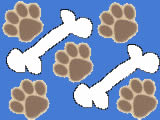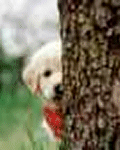Here is your 1st training lesson.
Foundation in Dog Training
As a preparation to our formal training program, we must first make sure our dogs are responding the right way. Use food when you start to train the dogs. I find that small pieces of carrots work best, or you could mix small pieces of hot dog, cheese, or carrots. This helps the dog in the begining to help maintain focus and allows us to program our Pavlov'a Law response.
Please train before you feed their meals. You will have better success. If they have a good training session, feed them immediately afterward so that they connect the training with the feeding.
|
The first skill in our first lesson is building attention and teaching our dog to respond to their name. Our goal is to get our dog to immediately turn their head and look up into our eyes. Start by rewarding quick glances, then increase the length of time they look at you. We want intense focus when we call their name. This is the most important lesson in dog training. Without attention we will get nowhere with our training program. So take your time and do this the best that you can. All problems can be solved if your dog is paying attention to your instruction. The second skill is targeting or start to teach the come behavior, but we don't use the "come" command at this point. This is because "come is really a running exercise and in the beginning our dogs are usually only walking toward us. So wait until they are running toward you before you start to use the "come" command. The exercise should start out slowly, then progress to greater and greater distances with a faster and faster pace. The distance that you run backward is in relation to the distance your dog will come when called. If you only run backward 10 feet your dog will generally think come is only a 10 foot exercise. When they are farther away they will think they do not need to respond. So make a point of traveling a great distance in your practice session. The third skill is simply releasing your dog. Be sure to reward with praise when your dog releases. Right now this skill frees your dog from the exercise, but later in our training program we will use the release as the reward. Allowing your dog to do their favorite exercise. Hopefully this will be to play with you, but it can allow the dog to smell and relieve themselves or any activity your dog like to do. This is their time, but it is your command that they are free. Remember you free your dog, don't let them free themselves.
|
Lesson 1
1. Call the dog's name using a consistent voice tone. When the dog makes eye contact with you, praise the dog enthusiastically, e.g.,"good dog", then give him a treat. Walk away, then repeat Step 1 again. If the dog ignores your call, get up close, let him smell the treat, then proceed with step one. This step can be practiced any time of the day or night.
|
|
freeclass1@dogskool.org
Practice these skills several times a day throughout your training course.







